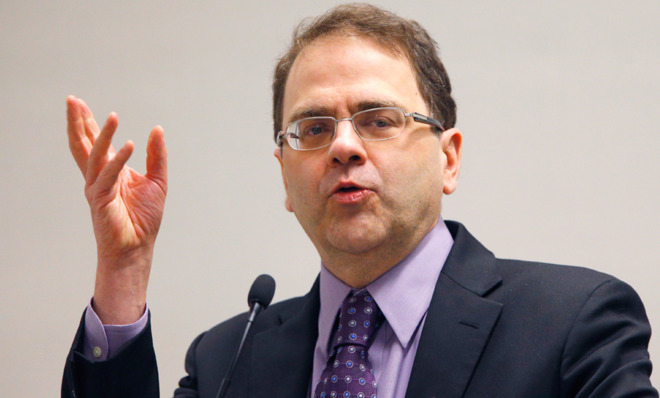The central banker who changed his mind
Why Narayana Kocherlakota's shift shouldn't come as a surprise

When Narayana Kocherlakota was appointed president of the Federal Reserve Bank of Minneapolis in 2009, the University of Chicago-educated theoretical economist was best known for his insight that money is a system of memory that encodes who has what, and who owes what to whom.
In the year before his appointment, he had signed a CATO Institute petition to protest President Obama's fiscal stimulus program. And after his appointment to the Fed, he was concerned that the central bank was being too accommodative. In August 2011, he was one of three policy-makers who voted against the statement promising to keep the Fed's benchmark interest rate target at near zero for two more years.
As a result, many viewed him as a "hawk" more concerned about the inflationary dangers of stimulatory policy than with trying to fight unemployment.
The Week
Escape your echo chamber. Get the facts behind the news, plus analysis from multiple perspectives.

Sign up for The Week's Free Newsletters
From our morning news briefing to a weekly Good News Newsletter, get the best of The Week delivered directly to your inbox.
From our morning news briefing to a weekly Good News Newsletter, get the best of The Week delivered directly to your inbox.
But by August 2012 he seemed to have changed his mind, noting that "increasing policy accommodation might well be appropriate" and voting later that year for the new quantitative easing asset-purchasing program (QE3). Michael S. Derby of the Wall Street Journal described Kocherlakota's shift as "an extreme swing from hawk to dove." Some have even alleged that Kocherlakota has fired colleagues who disapprove of his supposed ideological shift.
But I don't think that Kocherlakota's shift has really been so very dramatic at all. Any attempts to pigeonhole Federal Reserve policy-makers on a linear scale from "hawk" to "dove" is silly because it ignores the situational variability of monetary policy-making. Federal Reserve policy is a product of a very explicit mandate: Low unemployment, with a current target rate of 5.5 percent, and low inflation, with a 2 percent target rate. If your goal is to use policy to steer the economy toward those rates, sometimes an approach aimed at fighting inflation will predominate, which is what occurred in the early 1980s under Fed Chairman Paul Volcker, when inflation was above 15 percent. And sometimes an approach aimed at fighting unemployment will predominate.
Inflation is currently below the Federal Reserve's target, while unemployment is above the target, so the Fed seems "dovish." If the situation were reversed and inflation was soaring, the Fed's behavior would be reversed. The Federal Reserve is a dynamic, not a static institution, and I think Kocherlakota simply updated his policy prescriptions based on new evidence about the state of the economy and the persistently high rate of unemployment.
Kocherlakota actually sees a close analogy between the days of Volcker, when fighting spiraling inflation was the Federal Reserve's top priority. From a speech he gave in September:
A free daily email with the biggest news stories of the day – and the best features from TheWeek.com
[A]s Paul Volcker said in his 1979 speech, it is not enough to formulate or communicate a goal. The committee has to stick to its formulated approach — that is, it must do whatever it takes to achieve its communicated goal. In the early 1980s, doing whatever it took meant being willing to keep money tight, even though interest rates and the unemployment rate rose to unusual heights. By doing whatever it took to achieve its goal, despite these short-term costs, the [Fed] was able to bring down inflation and inflation expectations.
Doing whatever it takes in the next few years will mean something different. It will mean that the [Fed] is willing to continue to use the unconventional monetary policy tools that it has employed in the past few years. Indeed, it will mean that the [Fed] is willing to use any of its congressionally authorized tools to achieve the goal of higher employment, no matter how unconventional those tools might be.
This is consistent with the thinking of other monetarists like Scott Sumner, David Beckworth, and, yes, Milton Friedman. In the monetarist worldview, high unemployment and low inflation are by definition symptoms of tight monetary policy. So while policy may have been more accommodative than before 2008, the low level of inflation and high level of unemployment illustrate to monetarists that policy has been nowhere near accommodative enough. Indeed as Scott Sumner has noted, Kocherlakota has made this point himself.
Whether the monetarist view on this is correct remains to be seen. Ultimately a central bank is an imperfect fighter of unemployment as it cannot create jobs directly, and so relies on transmission mechanisms that are at best vaguely understood, and that sometimes may be more beneficial to the wealthy than everyone else. And there may be factors that keep unemployment high and inflation low no matter how hard the central bank pushes.
But while unemployment is high and inflation remains low, the central bank can push. Indeed, its mandate demands that it push. Nobody should be surprised to see central bankers like Kocherlakota doing just that.
John Aziz is the economics and business correspondent at TheWeek.com. He is also an associate editor at Pieria.co.uk. Previously his work has appeared on Business Insider, Zero Hedge, and Noahpinion.


